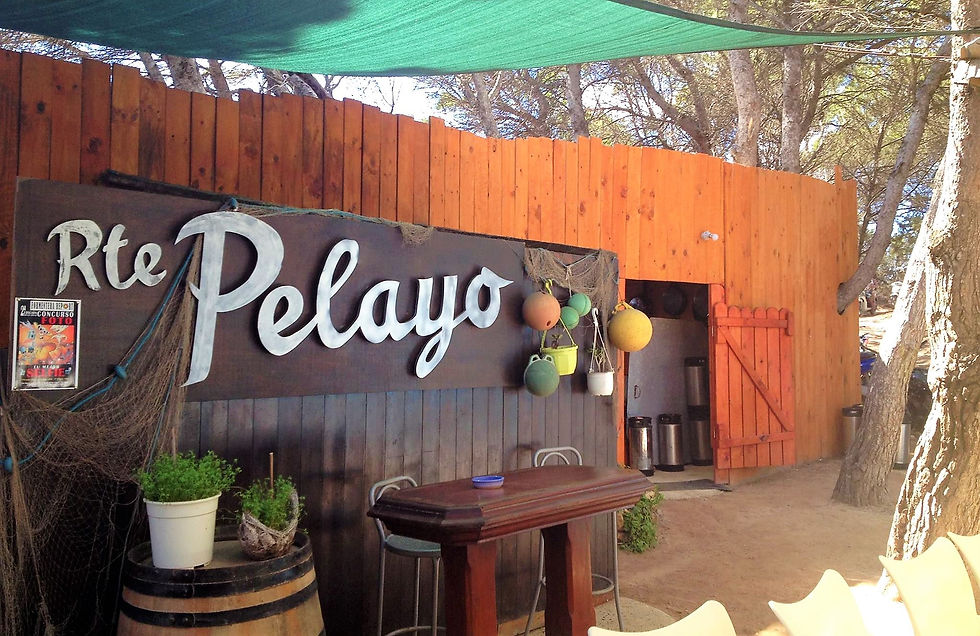FORMENTERA - PLATJA DE MIGJORN - RESTAURANTE PELAYO
- Miguel Renoir Spanish Guides

- May 30, 2025
- 3 min read
Updated: Nov 28, 2025
RESTAURANTE PELAYO
This is the perfect spot for a Sunday lunch with friends and family. It is a rustic, unpretentious beachside bar and Restaurant built in the true soul and spirit of Formentera.

Good food is served in a lovely location on the beach, with mostly locals and a few tourists, in a relaxed, easy-going atmosphere.


They serve delicious fish, octopus, and other seafood, but on Sunday, everyone goes for the Paella, which has an insane quantity of seafood!

Turn off at the Tortuga Restaurant (Carretera La Mola, Km 6.5) and head towards the coast and Platja de Migjorn, where you will find yourself on a dirt road overlooking wheat fields once brought to the island by the Romans. Stone walls divide the fields built by the Moors in the 9th century. Everywhere you look, you will see history.
Some unprofessional signs point the way past curves and turns; you will spy them out of the corner of your eye because they remain obscure and haphazardly placed. You will drive on dirt roads, some of the worst on the island.

You will eventually see the sign saying Pelayo with an arrow; carry on, and you will find a Robin Hood-like encampment nestled in a glen. Ramshackle buildings, haphazardly placed of corrugated tin, are thrown in a pickup, straw fashion, and cars are parked wherever there is space.


One shed houses a fierce fire, stoked furiously. On top of the fire, you will see a large pan filled with golden rice bursting with shrimp, mussels, and vegetables. You have arrived!

A roar lets it be known that the Paella is ready, and servers quickly spring into action, scooping out mounds of the ambrosia into heaped piles on plates. Settle down to enjoy your meal.



Paella is an ancient dish that originated from two cultures, the Romans and the Arabs. From Sanskrit comes the word "Pa," meaning utensil or pitcher, which gave rise to "Paella," which came to mean the pan in which the meal was cooked. Not until much later in the 18th century did the word come to mean the actual dish. The Romans introduced irrigation and utensils, while the Arabs introduced rice. Rice cultivation was prevalent around Valencia on the Spanish mainland, and the typical dish evolved into what is now known as Paella.
Then, it was primarily snails, rabbits, and rice from the local lands. Later, it morphed to include seafood because Valencia was coastal, and meat-and-seafood combinations emerged. Spices were an essential addition to Paella, and with its golden hue, saffron was the crowning effect, making the dish flavourful and aesthetically pleasing. Garlic is a must, along with smoked paprika, green beans, and sometimes red peppers as a garnish.
Because there was a lack of dry, slow-burning wood in Spain, green lumber had to be used, which produced a very hot fire; this led to the development of the art of frying. For this, a large pan could range in size from a record album to several feet in diameter. A flat pan, suitable for being over a fire, was created and would always measure from the knuckle of the thumb in depth to keep the rice in maximum contact with the bottom of the pan.
The only way to experience Paella is to cook it over an outdoor fire, preferably with wood from olive, orange, or pine trees, which gives it an aromatic flavour. Paella cooked indoors on a stove doesn't compare to the authentic version.
Apologies to any Valencianos regarding the recipe, as it is often disputed.


Do not expect low prices—this is Formentera—but the Paella is reasonably priced compared to other restaurants on the island: only €20.


Every Sunday, they feature a live Latin band, allowing you to dance and enjoy Paella.


Most of the words © Jonathon Lipsin
You can find Jonathon's Formentera hippy music picks here
Also, Bernadette's Formentera Blues here
RESTAURANTE PELAYO
Platja Migjorn, Formentera, Spain
+34 669 98 40 08
You can follow us on:
INSTAGRAM - @renoirspanishguides
YOUTUBE - Renoir Spanish Guides
MIXCLOUD MUSIC - Mikeyb
TIKTOK - Renoir Spanish Guides
TWITTER - @RenoirGuides
FACEBOOK - Renoir Spanish Guides - Food, Drink & Places






Comments